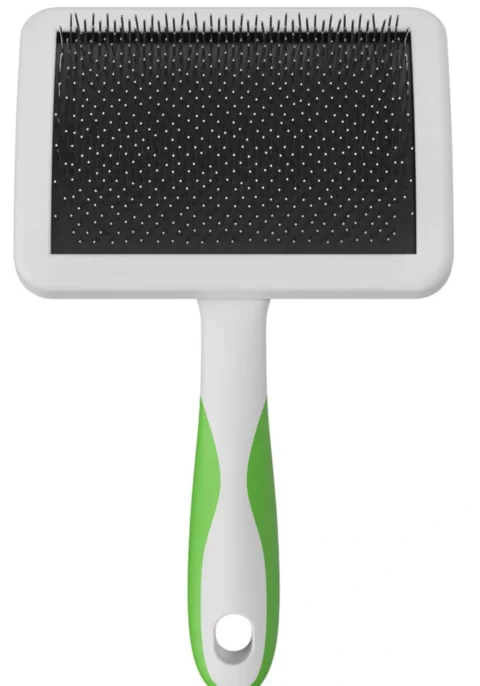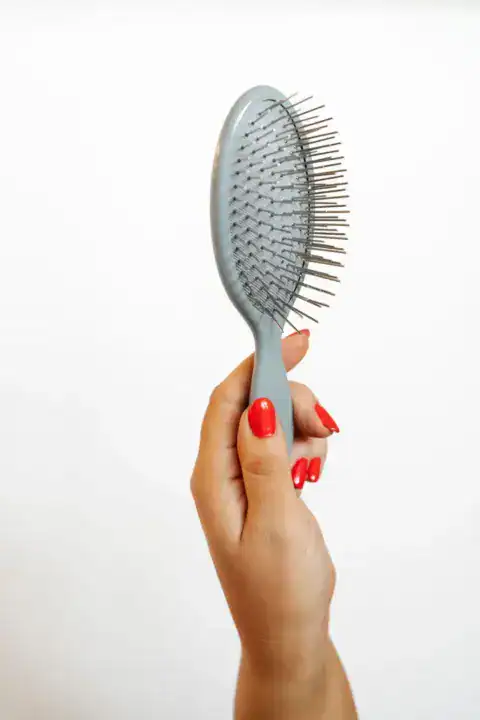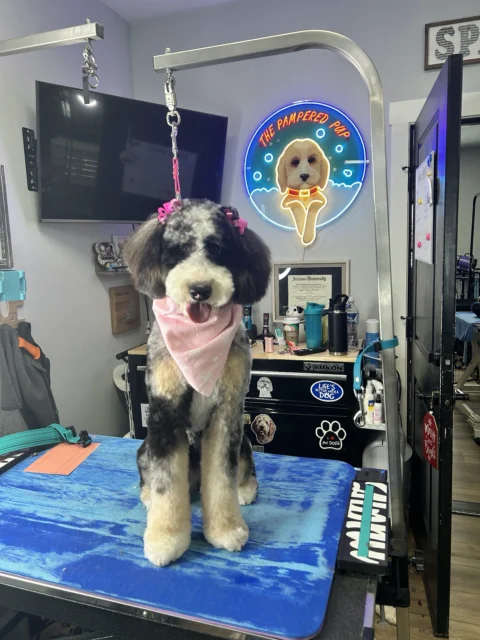As any responsible Bernedoodle owner knows, Bernie’s require a ton of maintenance and upkeep when it comes to their fur.
In addition to frequent grooming sessions, it’s also important that you keep up with their fur between professional appointments. In order to do that, you’ll need the right tools for the job, including a high-quality brush.
If you’re new to dog ownership and aren’t sure which brush is right for you, you’ve come to the right place.
At Fawn River Doodles, we brush and clean dozens of dogs a week, which means we’re well-informed when it comes to grooming equipment.
Our goal is to pass this knowledge on to you so that you can take proper care of your precious Bernedoodle.
What is the best brush for cleaning a Bernedoodle?
At Fawn River Doodles, we brush a ton of dogs. In our experience, we’ve found that the Wahl Slicker Brush is our personal favorite. It’s highly durable and has soft, gentle bristles that are still tough enough to remove burrs, mats, and things that can damage your dog’s fur.
While we love our Wahl Slicker Brush, we also use Pupwell’s Everyday Slicker Brush. It’s a high-quality, professional-grade option, but it’s also on the pricier side and might be more than most pet owners need.
Therefore, we’ve found that the Wahl brush is a good, middle-of-the-road option in that it’s fairly affordable and gets the job done.


The How much should I expect to spend on a dog brush?
You can spend however much you want on a brush for your Bernedoodle, as prices range from $10 to $70. Personally, the most we spend on our slicker brushes is right around $20. We’ve found that brushes at this price are strong and long-lasting.
The Pupwell slicker brush we referenced earlier, on the other hand, rings in at $55. While it’s likely a better overall brush, our $20 Wahl brush is great for our purposes.

Are there extra attachments I should have for my brush?
In addition to having a high-quality slicker brush, there are a few other tools it’s good to have on hand when brushing your dog. Here are a few of the most important items to consider:
- Vacuum and dryer
- Grooming brush
- Cleaning tool
- Detangler
- Desheder
- Dematter
- Trimmer with guards
- Vacuum hose attachment
While you can brush your dog without these tools, they make it much easier and will help you do a better job. It will also help you go longer between grooming appointments or will even allow you to groom your dog yourself!
If you want all of these items in one convenient package, it’s available through Uproot with the Uproot Pet Grooming Kit.
If you do indeed plan to start doing your own grooming, it may definitely be worthwhile investing in a high-quality vacuum and blower.
Having a blow dryer and vacuum that attaches directly to your Bernedoodle clippers will save a ton of time during cleanup. It will also make for a faster and easier grooming experience, which is essential for groomers of any experience level.
Different types of brushes for Bernedoodles
Here’s a quick look at some of the different types of brushes that you can use on your Bernedoodle.
Slicker brushes
A slicker brush consists of numerous short bristles that are soft and flexible. They’re the best option for getting rid of mats and loose hair without irritating the skin.
You can use these brushes on numerous different types of coats, making them a good all-around option. Like we said before, we prefer the Wahl slicker brush, but there are a number of high-quality brands out there.
Firm slicker brushes
While soft slicker brushes are good for dogs with fine coats and sensitive skin, firm slicker brushes have their advantages as well. For instance, firm slicker brushes are better for dogs with thicker, coarser, or curlier coats, because they can dig deeper and remove tough mats.

Combs
In addition to a high-quality slicker brush, you’re also going to want to have a comb or two on hand. Combs are ideal for brushing around the face and ears, while brushes are better suited for bodywork and paws.
Pin brushes
A pin brush is similar to a hairbrush that long-haired humans use. It consists of widely-spaced metal pins that are solid and less flexible than the thistles on slicker brushes.
Pin brushes are ideal for long-haired dogs that tend to get overly dirty or shed frequently. However, while they do a great job on the surface, pin brushes don’t penetrate as deeply as slicker brushes.
As such, while it’s a good idea to have both types of brushes on hand, slicker brushes are the more important one. In other words, if you’re only going to spend money on one brush, you would do well to choose the slicker brush.
You can take it from us because a slicker brush is the only type of brush we use at Fawn River Doodles.

What types of bristles work best for Bernedoodles?
In addition to different types of brushes for Bernedoodles, you can also choose different types of bristles for your brushes. However, we’ve found that metal bristles are the only bristles worth using.
We’ve never used brushes with plastic bristles, as they typically have a cheaper and slightly flimsier feel and design to them. Metal bristles, on the other hand, are ideal for getting deep into a Bernedoodles thick fur.
You can also give natural bristles, such as horse hair bristles a try, but we’ve never dabbled with these types of brushes. Metal brushes haven’t failed us yet, and we’ve found them to offer the best and most consistent results.
The importance of frequent brushing for your Bernedoodles’ health and wellness
Frequently brushing your Bernedoodle doesn’t just help them feel fresh and clean and shed less – it’s also good for their health.
If enough dirt, debris, and mats build up in their fur, Bernedoodles are more prone to parasites, bugs, insects, ticks, mites, and other unwanted things getting into their fur.
As such, we recommend brushing your Bernedoodle thoroughly at least two to three times per week.
While that might sound like a lot, it’s well worth the investment. The more often you brush your Bernedoodle, the healthier they will be and the easier it will be to groom them. As such, you’ll save money on vet bills and grooming sessions!
What problems can you run into if you don’t brush them enough?
The most common issues you run into if you don’t brush your Bernedoodle enough is that their fur will get pretty nasty.
This often manifests in fur knots and mats and will also make your dog more prone to ear infections. Your doodle also won’t have the nice, fluffy coat that gives them their signature curly look.
What’s the best process for grooming a Bernedoodle?
When it comes right down to it, you can groom and brush your Bernedoodle in a number of different ways. What we’ve found works best, however, is to start with a dematting undercoat rake.
This is especially important if your dog’s hair is extra long and matted. From there, we proceed to brush the body and paws and comb around the ears and face.
If you’re doing a full-blown grooming session, you would then want to use scissors to trim around the ears, paws, whiskers, and face. You would then want to wash and dry your dog before you use your clippers to give your pooch a proper haircut.

Tips and tricks to make brushing your Bernedoodle easier
Bernedoodle can have a fairly wide range of coat types, ranging from long straight or wavy to fluffy and curly. The type of coat your dog gets depends on how much poodle they have in them.
However, regardless of what type of coat your Bernedoodle has, we’ve found that our Wahls slicker brush can get the job done.
Should I use a detangler when brushing my Bernedoodle?
Without a doubt, you should definitely use a detangling spray when brushing your Bernedoodle. You’ll be amazed at the difference a good detangler can make when brushing your doodle, as it helps to loosen mats, detangle knots, and free up loose hair.
Your dog will also thank you for using a detangler because it will help your brush pull less as you’re grooming them. This results in a smoother and less painful brushing and grooming experience.
However, it’s important to use a detangler that’s formulated for your dog’s skin. Bernedoodles are notorious for having sensitive skin that’s prone to irritation, rashes, and itchiness. Therefore, you should only use detangler spray that’s approved for doodles.
How to use a detangling spray
Detangling sprays are fairly easy to use. However, if it’s your first time and you don’t want to risk hurting your dogs’ skin, here’s how to properly use detangling spray:
- Spray liberally – It’s important that you don’t hold back when you’re using detangler. You should use as much as necessary to easily brush through your dog’s fur. Make sure to apply it evenly and liberally to the surface of their coat, but focus on areas that are especially matted.
- Brush thoroughly – Once you’ve thoroughly applied the detangler, you should brush your dog’s fur just as thoroughly. Start with a slicker brush and continue with a comb until you’ve worked your way completely through your dog’s fur. Be patient, and take extra time to remove tangles and knots as you go!
- Apply conditioner – After you’ve brushed and detangled your dog’s fur, the next step is to apply a conditioner. If you don’t want to give your dog a full-blown bath, you can use a leave-in conditioner. As the name implies, you apply the conditioner to your dog’s fur, rub it in, and leave it. This type of conditioner is easy to use and a Godsend when you aren’t in the mood to give your dog a bath.
- Give them a bath – If you don’t want to use a leave-in conditioner, the next step after brushing your Bernedoodle is to give them a bath. Bathing is a good idea once a week or every other week, as bathing more often could irritate your dog’s skin. If you do decide to bathe your dog, it’s crucial to brush them before and not after the bath, as brushing after a bath can result in pulling out excessive amounts of your dog’s fur.
In summary, the most important things to remember when detangling and brushing your Bernedoodle are:
- Brush your dog before bathing them
- Use plenty of detangler and apply it evenly
- Brush your dog thoroughly and remove all the detangler
- If necessary, you can lightly brush your dog after a bath, as long as you dry them thoroughly first. This can help distribute natural oils throughout their fur and skin.
What do people on Reddit think about what’s the best brush for Bernedoodles?
Reddit is a great place to turn to when you’re looking for fast answers to tough questions, such as which brush is best for Bernedoodles. To that end, here’s a helpful quote from one dedicated user:
“I use a tangle teezer first, then line brush using a slicker brush (I have a cheap one that works fine but will probably upgrade to the Chris Christensen one when I can), then go through with a steel comb to check for lingering tangles.
If I do notice any mats I cut them out but that has only been a problem when I left for a few days and my husband didn’t brush him correctly. I also use a detangling spray.
I spend 30+ minutes most evenings with this routine as well as quickly running the tangle teezer through his fur throughout the day when I notice it starting to tangle, but I expect to spend longer as my boy’s puppy fur grows out. The main thing I’d recommend is making sure you line brush rather than just brushing straight through in one long line.”
This lines up almost exactly with the process we use and recommend for our dogs at Fawn River Doodles.
Final thoughts
Whether you prefer the one from Wahl, Pupwell, or another brand, it’s important to have a high-quality and reliable slicker brush for your Bernedoodle.
While you should also have a good pin brush and comb, the slicker brush will be the number one tool in your brushing arsenal.
You should use it on a regular basis to brush and groom your Bernedoodle, especially if you want them to have a fluffy, adorable coat that will make them the envy of the neighborhood.

